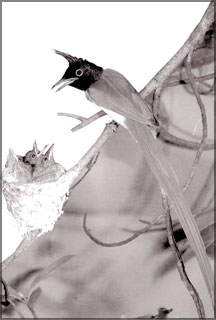That eccentric bird: The “Gini Hora”
by K. G. H. Munidasa
I have no doubt that many of the readers may, one time or another,
have seen the Ceylon Paradise Flycatcher, popularly called the “Gini
Hora”, though I am nevertheless certain that only a few among them could
claim of having ever seen its white cousin, the Indian Paradise
Flycatcher. And of the two the latter is the more attractive.
In India there is a legend why the adult flycatcher drops its
chestnut colour and adopts a white plumage.
Among our villagers too, there is a belief that the white-phase (“Kiri
Hora”) is a rare resident bird, which annually sheds its long tail
streamers, and goes into hiding in the heart of the jungle until a new
tail is grown.
|

Ceylon Paradise Flycatcher |
The fact is that the White Paradise Flycatcher, Terpsiphone paradisi
paradisi is purely a migrant species arriving here from the Indian
mainland in Winter (December to February) and going there back again
during the following Spring (March to May), to breed.
Anybody who is looking at a White Paradise Flycatcher for the first
time is liable to take for granted that it was born like that. It is not
so! Irrespective of sex, the young of both the Indian and Lankan races
are generally chestnut in plumage with blue-black head and whitish
underparts.
After the first annual moult, the two central tail feathers of the
male begin to lengthen and grow to a length of 12 to 15 inches, with the
second moult. In the third moult the male of the Indian race gradually
changes from chestnut to white plumage, and by the fourth moult it
becomes completely white, except the head, throat and crest which take
up a glossy blue-black colour.
The male of the Lankan race, Terpsiphone paradisi ceynensis and the
females of both the races continue in the chestnut phase throughout
their life. The females do not however, carry long tail streamers. Yet
males of the Lankan race have occasionally been found to sport white
tail streamers or even one chestnut and the other white.
The Paradise Flycatcher (Sub-Family: Monarchiae) is found in
Turkestan, Afghanistan and Baluchistan, through the greater part of
India to Burma and still further eastwards. Three forms are described
from the Indian region, out of which the typical race paradisi occurs in
the hills and dales of peninsular India and visits Sri Lanka during the
North-East Monsoon.
The race leucogaster, which differs from the first mentioned in size
and details of colorations inhabits Afghanistan, Turkestan, Kashmir and
through the Himalayas to East Nepal. The other Nicobarica, which has the
head, neck and breast ashy-grey with only the cap and crest black is
found in Assam, migrating to the Nicobars and Andaman Islands, in
winter. The race ceylonensis is endemic to this island.
Within its breeding rage the Paradise Flycatcher moves about a great
deal. Thus with different locations in India it holds different status.
In one place it is a “Summer Visitor”, a “Passage Migrant” in another,
and still in another locality it is called a “Scarce Winter Visitor”.
This seasonal movement is evident even with the Lankan race. For
instance, in the North-East Monsoon period Paradise Flycatchers disperse
all over wet and the dry zones, and in the hills to a level of at least
3,700 feet elevations.
About March to April they begin to move out again and concentrate in
the forest tracts of the drier areas, where they pair and breed, during
May and June. |
